Workforce Planning in NHS: A Business Case for Improvement Report
VerifiedAdded on 2023/06/13
|14
|4232
|215
Report
AI Summary
This report provides an analysis of workforce planning within the National Health Service (NHS), a prominent public sector healthcare organization in the UK. It explores the strengths of workforce planning, such as minimizing recruitment costs, enhancing employee retention, and addressing talent gaps. The report also examines weaknesses, including the potential for increased risk due to reliance on forecasting, the time-consuming nature of planning processes, and the inflexibility that can arise from pre-defined policies. A business case is presented, outlining strategies to maximize strengths and address weaknesses, focusing on recruiting qualified employees, motivating staff, and increasing efficiency through training. The business case considers costs, including recurrent and non-recurrent expenses, and highlights financial and non-financial benefits such as increased profitability and improved long-term goal alignment within the NHS.
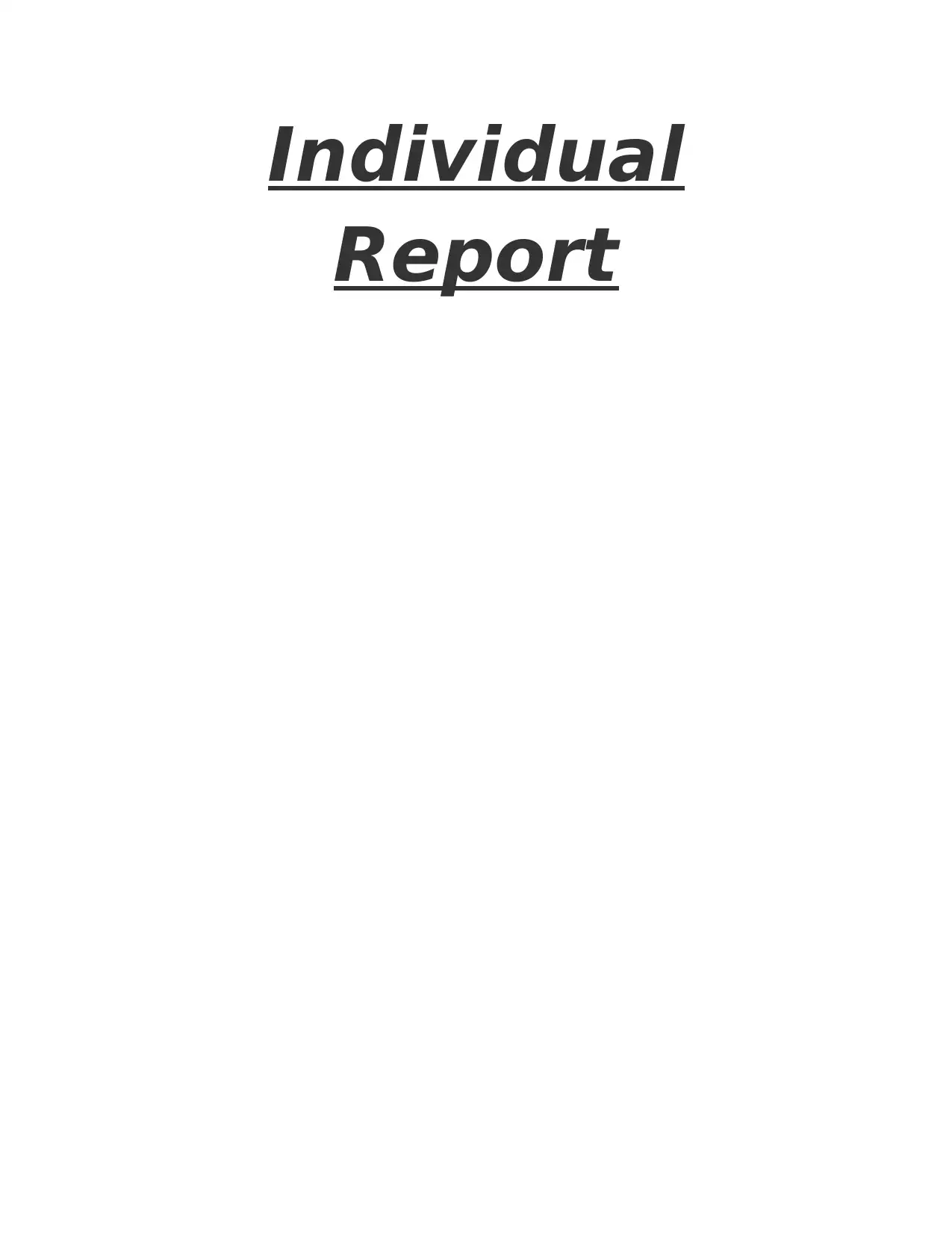
Individual
Report
Report
Paraphrase This Document
Need a fresh take? Get an instant paraphrase of this document with our AI Paraphraser
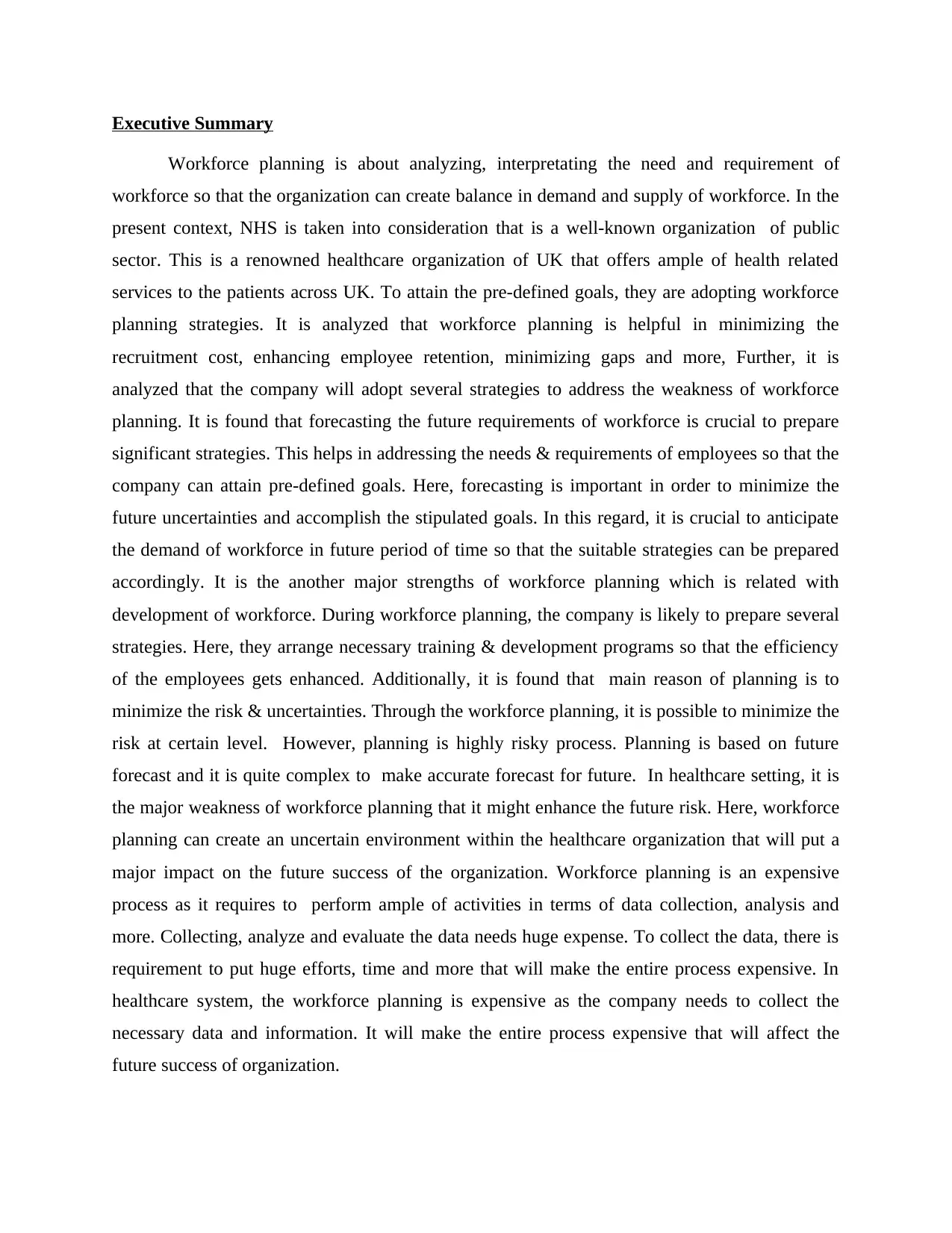
Executive Summary
Workforce planning is about analyzing, interpretating the need and requirement of
workforce so that the organization can create balance in demand and supply of workforce. In the
present context, NHS is taken into consideration that is a well-known organization of public
sector. This is a renowned healthcare organization of UK that offers ample of health related
services to the patients across UK. To attain the pre-defined goals, they are adopting workforce
planning strategies. It is analyzed that workforce planning is helpful in minimizing the
recruitment cost, enhancing employee retention, minimizing gaps and more, Further, it is
analyzed that the company will adopt several strategies to address the weakness of workforce
planning. It is found that forecasting the future requirements of workforce is crucial to prepare
significant strategies. This helps in addressing the needs & requirements of employees so that the
company can attain pre-defined goals. Here, forecasting is important in order to minimize the
future uncertainties and accomplish the stipulated goals. In this regard, it is crucial to anticipate
the demand of workforce in future period of time so that the suitable strategies can be prepared
accordingly. It is the another major strengths of workforce planning which is related with
development of workforce. During workforce planning, the company is likely to prepare several
strategies. Here, they arrange necessary training & development programs so that the efficiency
of the employees gets enhanced. Additionally, it is found that main reason of planning is to
minimize the risk & uncertainties. Through the workforce planning, it is possible to minimize the
risk at certain level. However, planning is highly risky process. Planning is based on future
forecast and it is quite complex to make accurate forecast for future. In healthcare setting, it is
the major weakness of workforce planning that it might enhance the future risk. Here, workforce
planning can create an uncertain environment within the healthcare organization that will put a
major impact on the future success of the organization. Workforce planning is an expensive
process as it requires to perform ample of activities in terms of data collection, analysis and
more. Collecting, analyze and evaluate the data needs huge expense. To collect the data, there is
requirement to put huge efforts, time and more that will make the entire process expensive. In
healthcare system, the workforce planning is expensive as the company needs to collect the
necessary data and information. It will make the entire process expensive that will affect the
future success of organization.
Workforce planning is about analyzing, interpretating the need and requirement of
workforce so that the organization can create balance in demand and supply of workforce. In the
present context, NHS is taken into consideration that is a well-known organization of public
sector. This is a renowned healthcare organization of UK that offers ample of health related
services to the patients across UK. To attain the pre-defined goals, they are adopting workforce
planning strategies. It is analyzed that workforce planning is helpful in minimizing the
recruitment cost, enhancing employee retention, minimizing gaps and more, Further, it is
analyzed that the company will adopt several strategies to address the weakness of workforce
planning. It is found that forecasting the future requirements of workforce is crucial to prepare
significant strategies. This helps in addressing the needs & requirements of employees so that the
company can attain pre-defined goals. Here, forecasting is important in order to minimize the
future uncertainties and accomplish the stipulated goals. In this regard, it is crucial to anticipate
the demand of workforce in future period of time so that the suitable strategies can be prepared
accordingly. It is the another major strengths of workforce planning which is related with
development of workforce. During workforce planning, the company is likely to prepare several
strategies. Here, they arrange necessary training & development programs so that the efficiency
of the employees gets enhanced. Additionally, it is found that main reason of planning is to
minimize the risk & uncertainties. Through the workforce planning, it is possible to minimize the
risk at certain level. However, planning is highly risky process. Planning is based on future
forecast and it is quite complex to make accurate forecast for future. In healthcare setting, it is
the major weakness of workforce planning that it might enhance the future risk. Here, workforce
planning can create an uncertain environment within the healthcare organization that will put a
major impact on the future success of the organization. Workforce planning is an expensive
process as it requires to perform ample of activities in terms of data collection, analysis and
more. Collecting, analyze and evaluate the data needs huge expense. To collect the data, there is
requirement to put huge efforts, time and more that will make the entire process expensive. In
healthcare system, the workforce planning is expensive as the company needs to collect the
necessary data and information. It will make the entire process expensive that will affect the
future success of organization.

⊘ This is a preview!⊘
Do you want full access?
Subscribe today to unlock all pages.

Trusted by 1+ million students worldwide
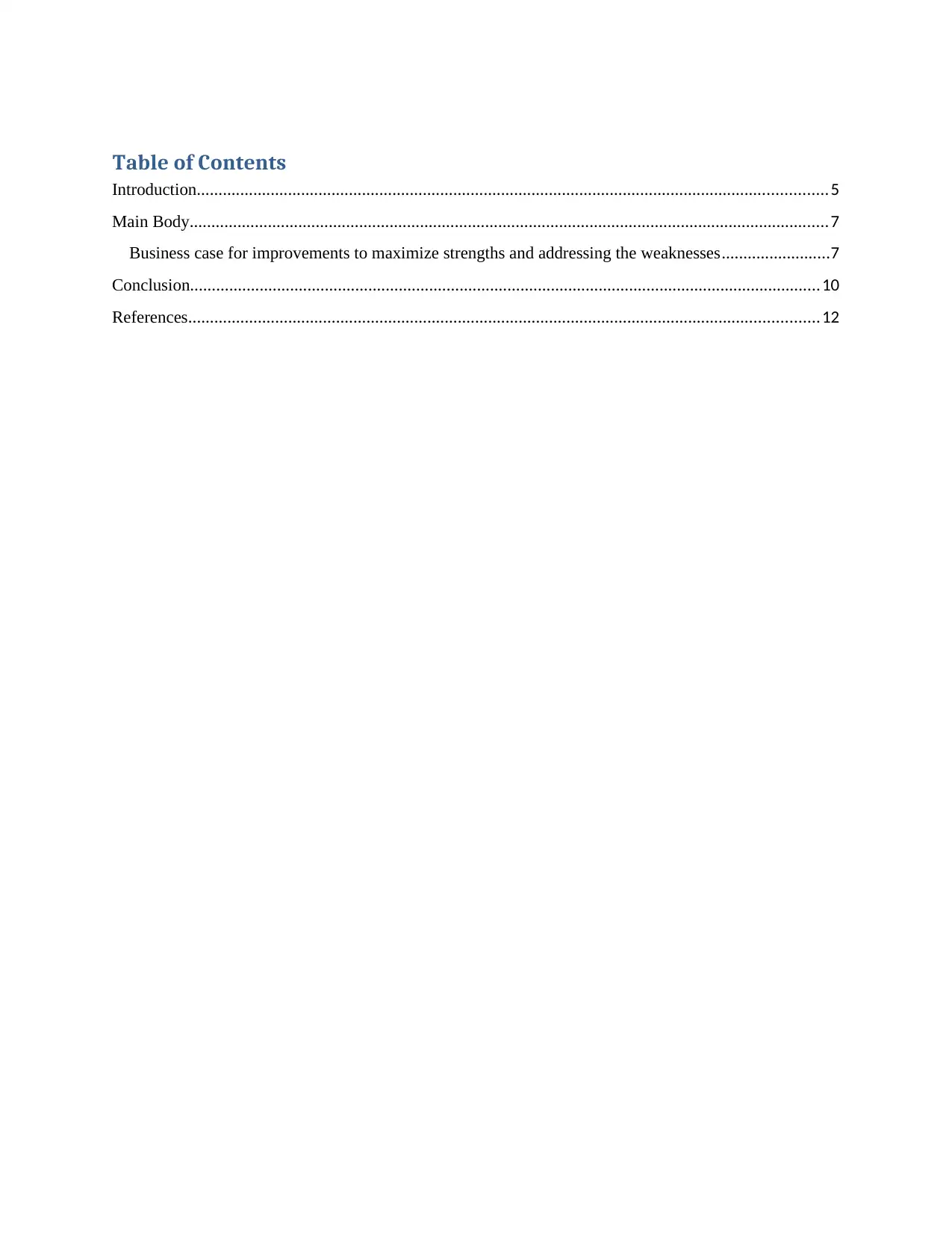
Table of Contents
Introduction.................................................................................................................................................5
Main Body...................................................................................................................................................7
Business case for improvements to maximize strengths and addressing the weaknesses.........................7
Conclusion.................................................................................................................................................10
References.................................................................................................................................................12
Introduction.................................................................................................................................................5
Main Body...................................................................................................................................................7
Business case for improvements to maximize strengths and addressing the weaknesses.........................7
Conclusion.................................................................................................................................................10
References.................................................................................................................................................12
Paraphrase This Document
Need a fresh take? Get an instant paraphrase of this document with our AI Paraphraser
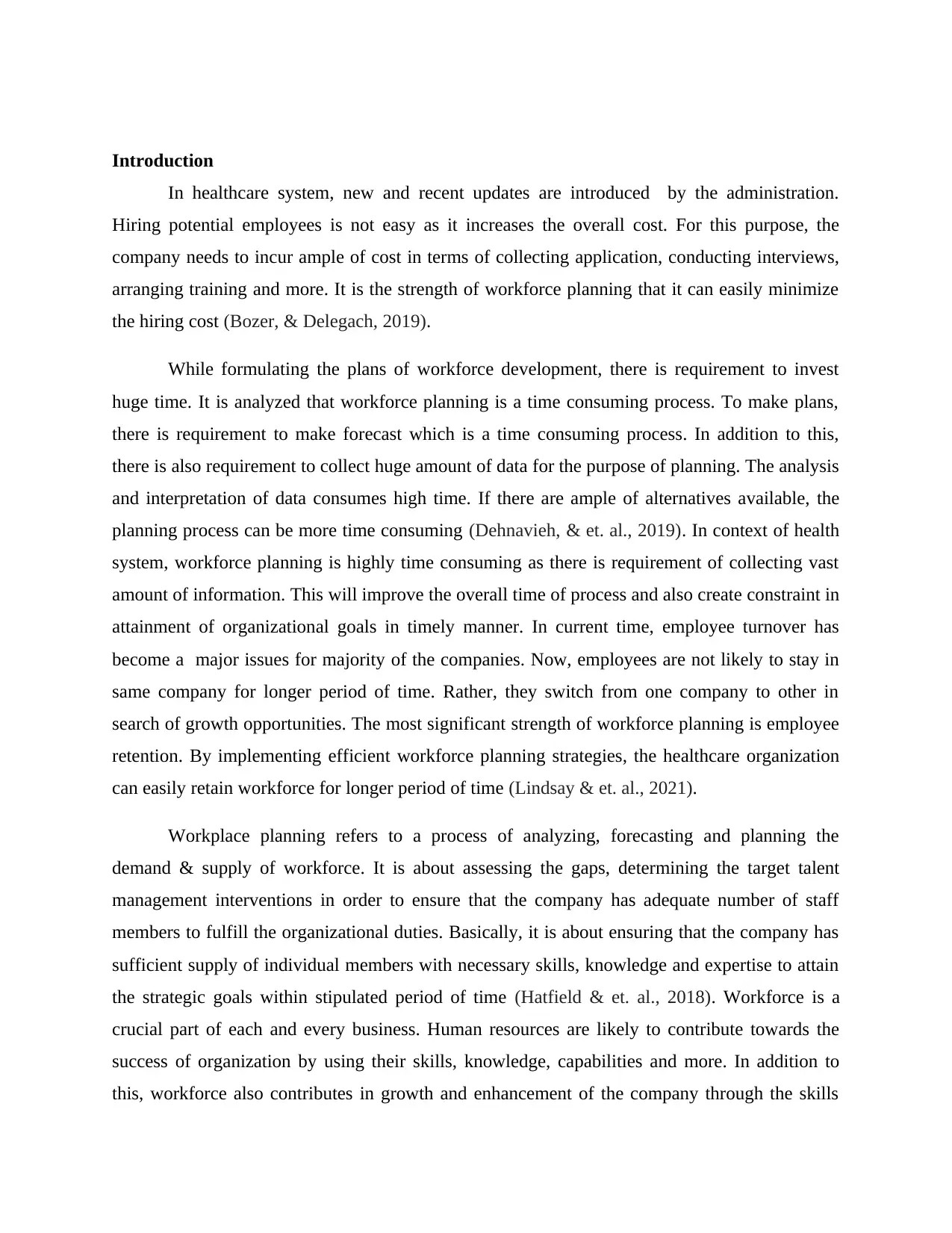
Introduction
In healthcare system, new and recent updates are introduced by the administration.
Hiring potential employees is not easy as it increases the overall cost. For this purpose, the
company needs to incur ample of cost in terms of collecting application, conducting interviews,
arranging training and more. It is the strength of workforce planning that it can easily minimize
the hiring cost (Bozer, & Delegach, 2019).
While formulating the plans of workforce development, there is requirement to invest
huge time. It is analyzed that workforce planning is a time consuming process. To make plans,
there is requirement to make forecast which is a time consuming process. In addition to this,
there is also requirement to collect huge amount of data for the purpose of planning. The analysis
and interpretation of data consumes high time. If there are ample of alternatives available, the
planning process can be more time consuming (Dehnavieh, & et. al., 2019). In context of health
system, workforce planning is highly time consuming as there is requirement of collecting vast
amount of information. This will improve the overall time of process and also create constraint in
attainment of organizational goals in timely manner. In current time, employee turnover has
become a major issues for majority of the companies. Now, employees are not likely to stay in
same company for longer period of time. Rather, they switch from one company to other in
search of growth opportunities. The most significant strength of workforce planning is employee
retention. By implementing efficient workforce planning strategies, the healthcare organization
can easily retain workforce for longer period of time (Lindsay & et. al., 2021).
Workplace planning refers to a process of analyzing, forecasting and planning the
demand & supply of workforce. It is about assessing the gaps, determining the target talent
management interventions in order to ensure that the company has adequate number of staff
members to fulfill the organizational duties. Basically, it is about ensuring that the company has
sufficient supply of individual members with necessary skills, knowledge and expertise to attain
the strategic goals within stipulated period of time (Hatfield & et. al., 2018). Workforce is a
crucial part of each and every business. Human resources are likely to contribute towards the
success of organization by using their skills, knowledge, capabilities and more. In addition to
this, workforce also contributes in growth and enhancement of the company through the skills
In healthcare system, new and recent updates are introduced by the administration.
Hiring potential employees is not easy as it increases the overall cost. For this purpose, the
company needs to incur ample of cost in terms of collecting application, conducting interviews,
arranging training and more. It is the strength of workforce planning that it can easily minimize
the hiring cost (Bozer, & Delegach, 2019).
While formulating the plans of workforce development, there is requirement to invest
huge time. It is analyzed that workforce planning is a time consuming process. To make plans,
there is requirement to make forecast which is a time consuming process. In addition to this,
there is also requirement to collect huge amount of data for the purpose of planning. The analysis
and interpretation of data consumes high time. If there are ample of alternatives available, the
planning process can be more time consuming (Dehnavieh, & et. al., 2019). In context of health
system, workforce planning is highly time consuming as there is requirement of collecting vast
amount of information. This will improve the overall time of process and also create constraint in
attainment of organizational goals in timely manner. In current time, employee turnover has
become a major issues for majority of the companies. Now, employees are not likely to stay in
same company for longer period of time. Rather, they switch from one company to other in
search of growth opportunities. The most significant strength of workforce planning is employee
retention. By implementing efficient workforce planning strategies, the healthcare organization
can easily retain workforce for longer period of time (Lindsay & et. al., 2021).
Workplace planning refers to a process of analyzing, forecasting and planning the
demand & supply of workforce. It is about assessing the gaps, determining the target talent
management interventions in order to ensure that the company has adequate number of staff
members to fulfill the organizational duties. Basically, it is about ensuring that the company has
sufficient supply of individual members with necessary skills, knowledge and expertise to attain
the strategic goals within stipulated period of time (Hatfield & et. al., 2018). Workforce is a
crucial part of each and every business. Human resources are likely to contribute towards the
success of organization by using their skills, knowledge, capabilities and more. In addition to
this, workforce also contributes in growth and enhancement of the company through the skills
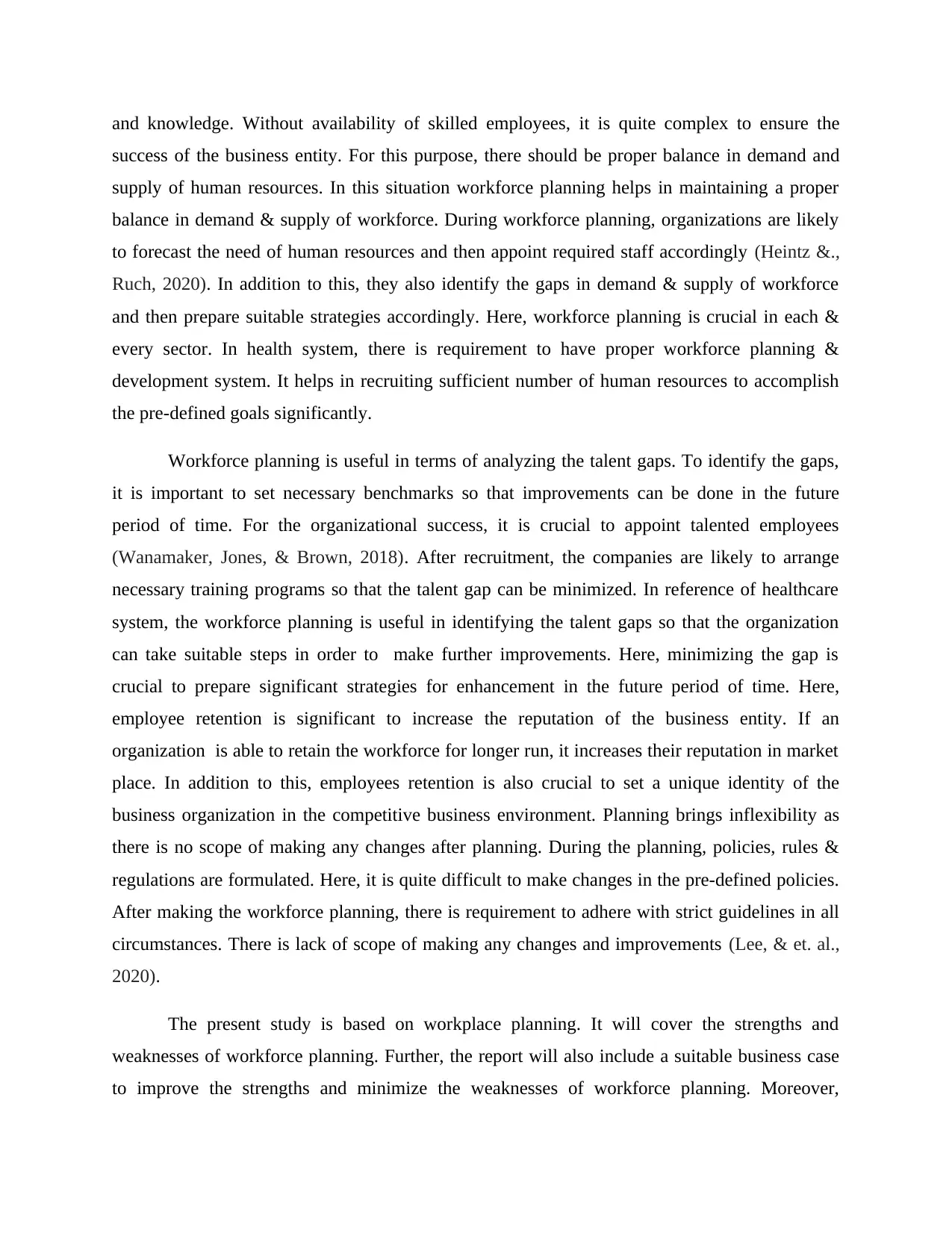
and knowledge. Without availability of skilled employees, it is quite complex to ensure the
success of the business entity. For this purpose, there should be proper balance in demand and
supply of human resources. In this situation workforce planning helps in maintaining a proper
balance in demand & supply of workforce. During workforce planning, organizations are likely
to forecast the need of human resources and then appoint required staff accordingly (Heintz &.,
Ruch, 2020). In addition to this, they also identify the gaps in demand & supply of workforce
and then prepare suitable strategies accordingly. Here, workforce planning is crucial in each &
every sector. In health system, there is requirement to have proper workforce planning &
development system. It helps in recruiting sufficient number of human resources to accomplish
the pre-defined goals significantly.
Workforce planning is useful in terms of analyzing the talent gaps. To identify the gaps,
it is important to set necessary benchmarks so that improvements can be done in the future
period of time. For the organizational success, it is crucial to appoint talented employees
(Wanamaker, Jones, & Brown, 2018). After recruitment, the companies are likely to arrange
necessary training programs so that the talent gap can be minimized. In reference of healthcare
system, the workforce planning is useful in identifying the talent gaps so that the organization
can take suitable steps in order to make further improvements. Here, minimizing the gap is
crucial to prepare significant strategies for enhancement in the future period of time. Here,
employee retention is significant to increase the reputation of the business entity. If an
organization is able to retain the workforce for longer run, it increases their reputation in market
place. In addition to this, employees retention is also crucial to set a unique identity of the
business organization in the competitive business environment. Planning brings inflexibility as
there is no scope of making any changes after planning. During the planning, policies, rules &
regulations are formulated. Here, it is quite difficult to make changes in the pre-defined policies.
After making the workforce planning, there is requirement to adhere with strict guidelines in all
circumstances. There is lack of scope of making any changes and improvements (Lee, & et. al.,
2020).
The present study is based on workplace planning. It will cover the strengths and
weaknesses of workforce planning. Further, the report will also include a suitable business case
to improve the strengths and minimize the weaknesses of workforce planning. Moreover,
success of the business entity. For this purpose, there should be proper balance in demand and
supply of human resources. In this situation workforce planning helps in maintaining a proper
balance in demand & supply of workforce. During workforce planning, organizations are likely
to forecast the need of human resources and then appoint required staff accordingly (Heintz &.,
Ruch, 2020). In addition to this, they also identify the gaps in demand & supply of workforce
and then prepare suitable strategies accordingly. Here, workforce planning is crucial in each &
every sector. In health system, there is requirement to have proper workforce planning &
development system. It helps in recruiting sufficient number of human resources to accomplish
the pre-defined goals significantly.
Workforce planning is useful in terms of analyzing the talent gaps. To identify the gaps,
it is important to set necessary benchmarks so that improvements can be done in the future
period of time. For the organizational success, it is crucial to appoint talented employees
(Wanamaker, Jones, & Brown, 2018). After recruitment, the companies are likely to arrange
necessary training programs so that the talent gap can be minimized. In reference of healthcare
system, the workforce planning is useful in identifying the talent gaps so that the organization
can take suitable steps in order to make further improvements. Here, minimizing the gap is
crucial to prepare significant strategies for enhancement in the future period of time. Here,
employee retention is significant to increase the reputation of the business entity. If an
organization is able to retain the workforce for longer run, it increases their reputation in market
place. In addition to this, employees retention is also crucial to set a unique identity of the
business organization in the competitive business environment. Planning brings inflexibility as
there is no scope of making any changes after planning. During the planning, policies, rules &
regulations are formulated. Here, it is quite difficult to make changes in the pre-defined policies.
After making the workforce planning, there is requirement to adhere with strict guidelines in all
circumstances. There is lack of scope of making any changes and improvements (Lee, & et. al.,
2020).
The present study is based on workplace planning. It will cover the strengths and
weaknesses of workforce planning. Further, the report will also include a suitable business case
to improve the strengths and minimize the weaknesses of workforce planning. Moreover,
⊘ This is a preview!⊘
Do you want full access?
Subscribe today to unlock all pages.

Trusted by 1+ million students worldwide
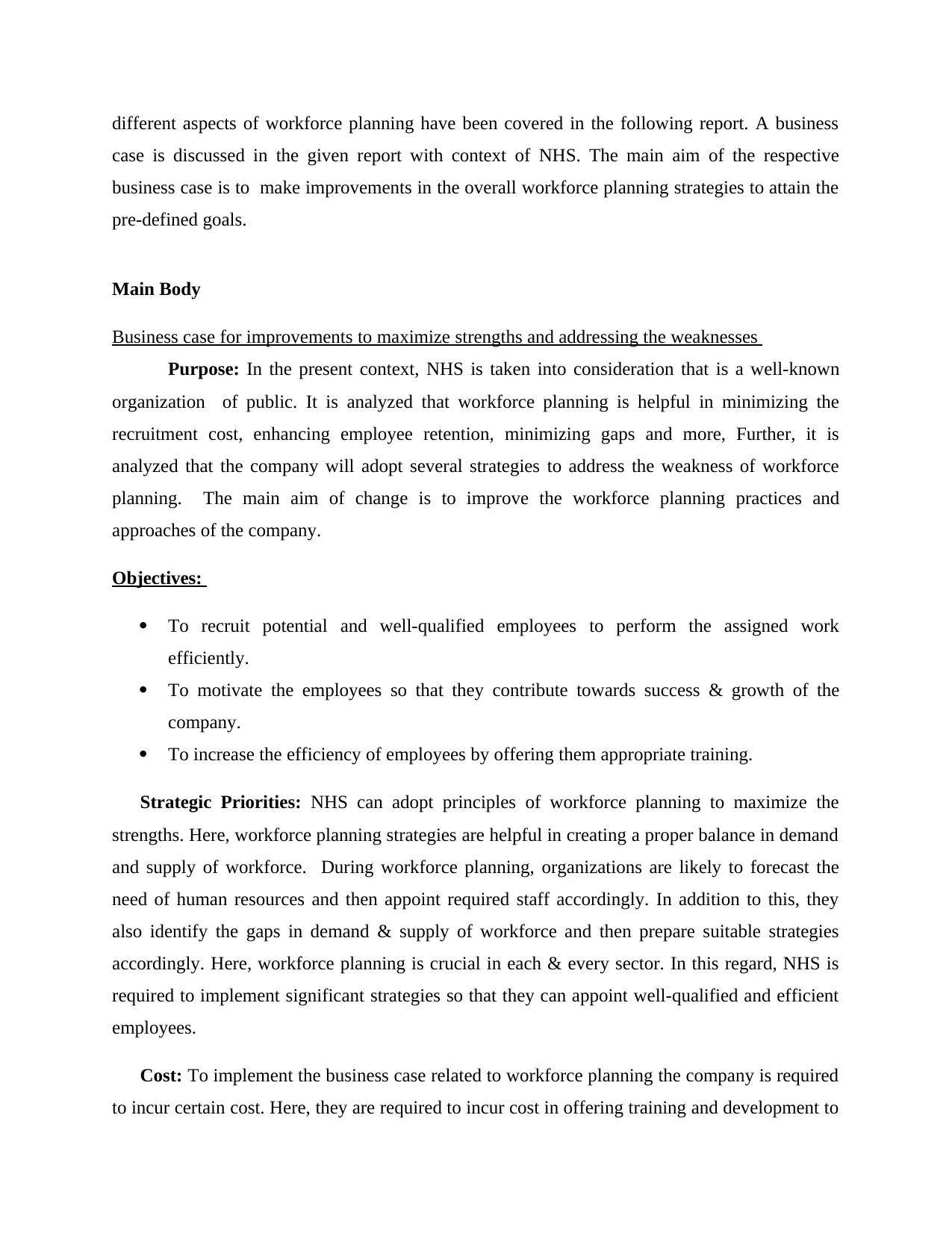
different aspects of workforce planning have been covered in the following report. A business
case is discussed in the given report with context of NHS. The main aim of the respective
business case is to make improvements in the overall workforce planning strategies to attain the
pre-defined goals.
Main Body
Business case for improvements to maximize strengths and addressing the weaknesses
Purpose: In the present context, NHS is taken into consideration that is a well-known
organization of public. It is analyzed that workforce planning is helpful in minimizing the
recruitment cost, enhancing employee retention, minimizing gaps and more, Further, it is
analyzed that the company will adopt several strategies to address the weakness of workforce
planning. The main aim of change is to improve the workforce planning practices and
approaches of the company.
Objectives:
To recruit potential and well-qualified employees to perform the assigned work
efficiently.
To motivate the employees so that they contribute towards success & growth of the
company.
To increase the efficiency of employees by offering them appropriate training.
Strategic Priorities: NHS can adopt principles of workforce planning to maximize the
strengths. Here, workforce planning strategies are helpful in creating a proper balance in demand
and supply of workforce. During workforce planning, organizations are likely to forecast the
need of human resources and then appoint required staff accordingly. In addition to this, they
also identify the gaps in demand & supply of workforce and then prepare suitable strategies
accordingly. Here, workforce planning is crucial in each & every sector. In this regard, NHS is
required to implement significant strategies so that they can appoint well-qualified and efficient
employees.
Cost: To implement the business case related to workforce planning the company is required
to incur certain cost. Here, they are required to incur cost in offering training and development to
case is discussed in the given report with context of NHS. The main aim of the respective
business case is to make improvements in the overall workforce planning strategies to attain the
pre-defined goals.
Main Body
Business case for improvements to maximize strengths and addressing the weaknesses
Purpose: In the present context, NHS is taken into consideration that is a well-known
organization of public. It is analyzed that workforce planning is helpful in minimizing the
recruitment cost, enhancing employee retention, minimizing gaps and more, Further, it is
analyzed that the company will adopt several strategies to address the weakness of workforce
planning. The main aim of change is to improve the workforce planning practices and
approaches of the company.
Objectives:
To recruit potential and well-qualified employees to perform the assigned work
efficiently.
To motivate the employees so that they contribute towards success & growth of the
company.
To increase the efficiency of employees by offering them appropriate training.
Strategic Priorities: NHS can adopt principles of workforce planning to maximize the
strengths. Here, workforce planning strategies are helpful in creating a proper balance in demand
and supply of workforce. During workforce planning, organizations are likely to forecast the
need of human resources and then appoint required staff accordingly. In addition to this, they
also identify the gaps in demand & supply of workforce and then prepare suitable strategies
accordingly. Here, workforce planning is crucial in each & every sector. In this regard, NHS is
required to implement significant strategies so that they can appoint well-qualified and efficient
employees.
Cost: To implement the business case related to workforce planning the company is required
to incur certain cost. Here, they are required to incur cost in offering training and development to
Paraphrase This Document
Need a fresh take? Get an instant paraphrase of this document with our AI Paraphraser
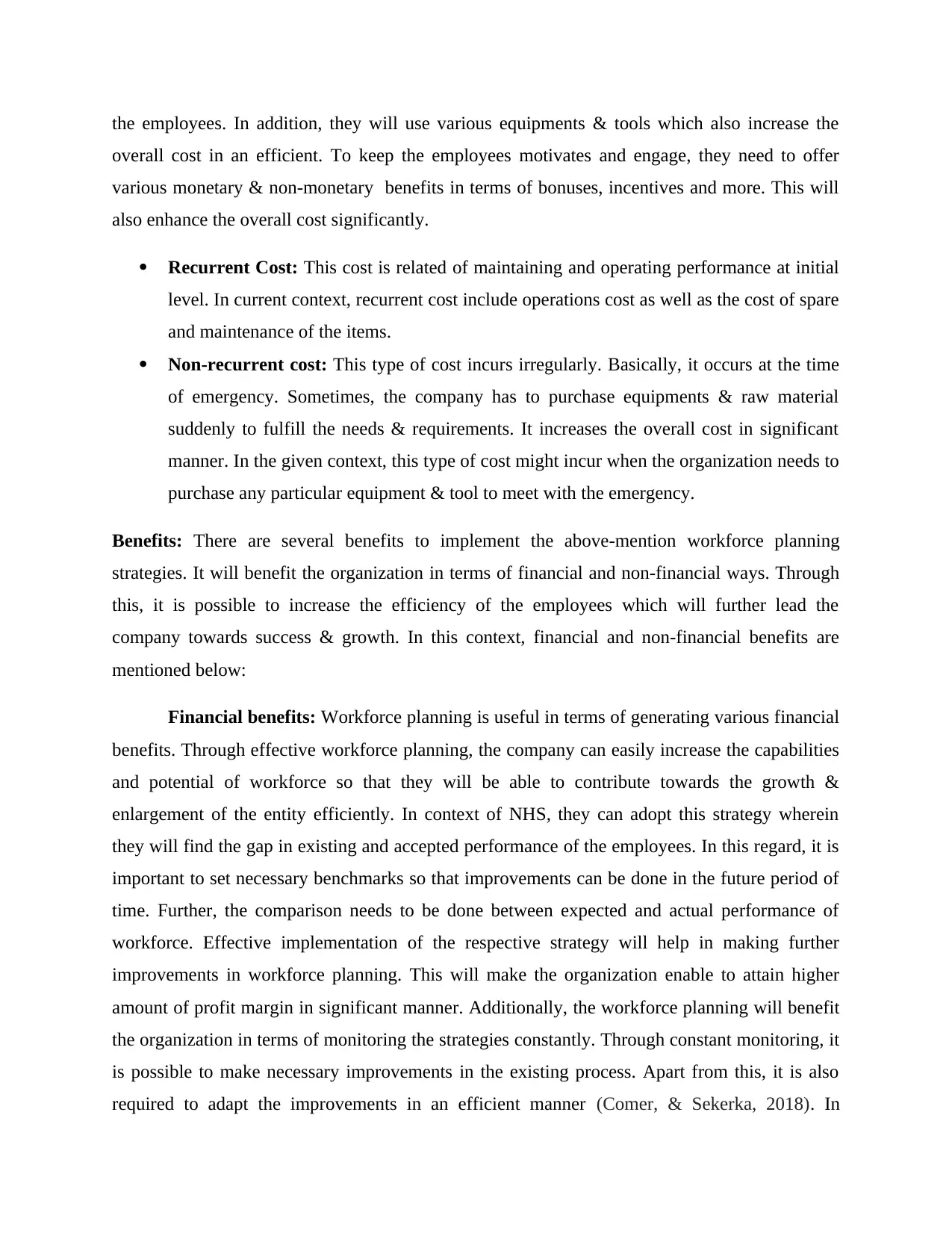
the employees. In addition, they will use various equipments & tools which also increase the
overall cost in an efficient. To keep the employees motivates and engage, they need to offer
various monetary & non-monetary benefits in terms of bonuses, incentives and more. This will
also enhance the overall cost significantly.
Recurrent Cost: This cost is related of maintaining and operating performance at initial
level. In current context, recurrent cost include operations cost as well as the cost of spare
and maintenance of the items.
Non-recurrent cost: This type of cost incurs irregularly. Basically, it occurs at the time
of emergency. Sometimes, the company has to purchase equipments & raw material
suddenly to fulfill the needs & requirements. It increases the overall cost in significant
manner. In the given context, this type of cost might incur when the organization needs to
purchase any particular equipment & tool to meet with the emergency.
Benefits: There are several benefits to implement the above-mention workforce planning
strategies. It will benefit the organization in terms of financial and non-financial ways. Through
this, it is possible to increase the efficiency of the employees which will further lead the
company towards success & growth. In this context, financial and non-financial benefits are
mentioned below:
Financial benefits: Workforce planning is useful in terms of generating various financial
benefits. Through effective workforce planning, the company can easily increase the capabilities
and potential of workforce so that they will be able to contribute towards the growth &
enlargement of the entity efficiently. In context of NHS, they can adopt this strategy wherein
they will find the gap in existing and accepted performance of the employees. In this regard, it is
important to set necessary benchmarks so that improvements can be done in the future period of
time. Further, the comparison needs to be done between expected and actual performance of
workforce. Effective implementation of the respective strategy will help in making further
improvements in workforce planning. This will make the organization enable to attain higher
amount of profit margin in significant manner. Additionally, the workforce planning will benefit
the organization in terms of monitoring the strategies constantly. Through constant monitoring, it
is possible to make necessary improvements in the existing process. Apart from this, it is also
required to adapt the improvements in an efficient manner (Comer, & Sekerka, 2018). In
overall cost in an efficient. To keep the employees motivates and engage, they need to offer
various monetary & non-monetary benefits in terms of bonuses, incentives and more. This will
also enhance the overall cost significantly.
Recurrent Cost: This cost is related of maintaining and operating performance at initial
level. In current context, recurrent cost include operations cost as well as the cost of spare
and maintenance of the items.
Non-recurrent cost: This type of cost incurs irregularly. Basically, it occurs at the time
of emergency. Sometimes, the company has to purchase equipments & raw material
suddenly to fulfill the needs & requirements. It increases the overall cost in significant
manner. In the given context, this type of cost might incur when the organization needs to
purchase any particular equipment & tool to meet with the emergency.
Benefits: There are several benefits to implement the above-mention workforce planning
strategies. It will benefit the organization in terms of financial and non-financial ways. Through
this, it is possible to increase the efficiency of the employees which will further lead the
company towards success & growth. In this context, financial and non-financial benefits are
mentioned below:
Financial benefits: Workforce planning is useful in terms of generating various financial
benefits. Through effective workforce planning, the company can easily increase the capabilities
and potential of workforce so that they will be able to contribute towards the growth &
enlargement of the entity efficiently. In context of NHS, they can adopt this strategy wherein
they will find the gap in existing and accepted performance of the employees. In this regard, it is
important to set necessary benchmarks so that improvements can be done in the future period of
time. Further, the comparison needs to be done between expected and actual performance of
workforce. Effective implementation of the respective strategy will help in making further
improvements in workforce planning. This will make the organization enable to attain higher
amount of profit margin in significant manner. Additionally, the workforce planning will benefit
the organization in terms of monitoring the strategies constantly. Through constant monitoring, it
is possible to make necessary improvements in the existing process. Apart from this, it is also
required to adapt the improvements in an efficient manner (Comer, & Sekerka, 2018). In
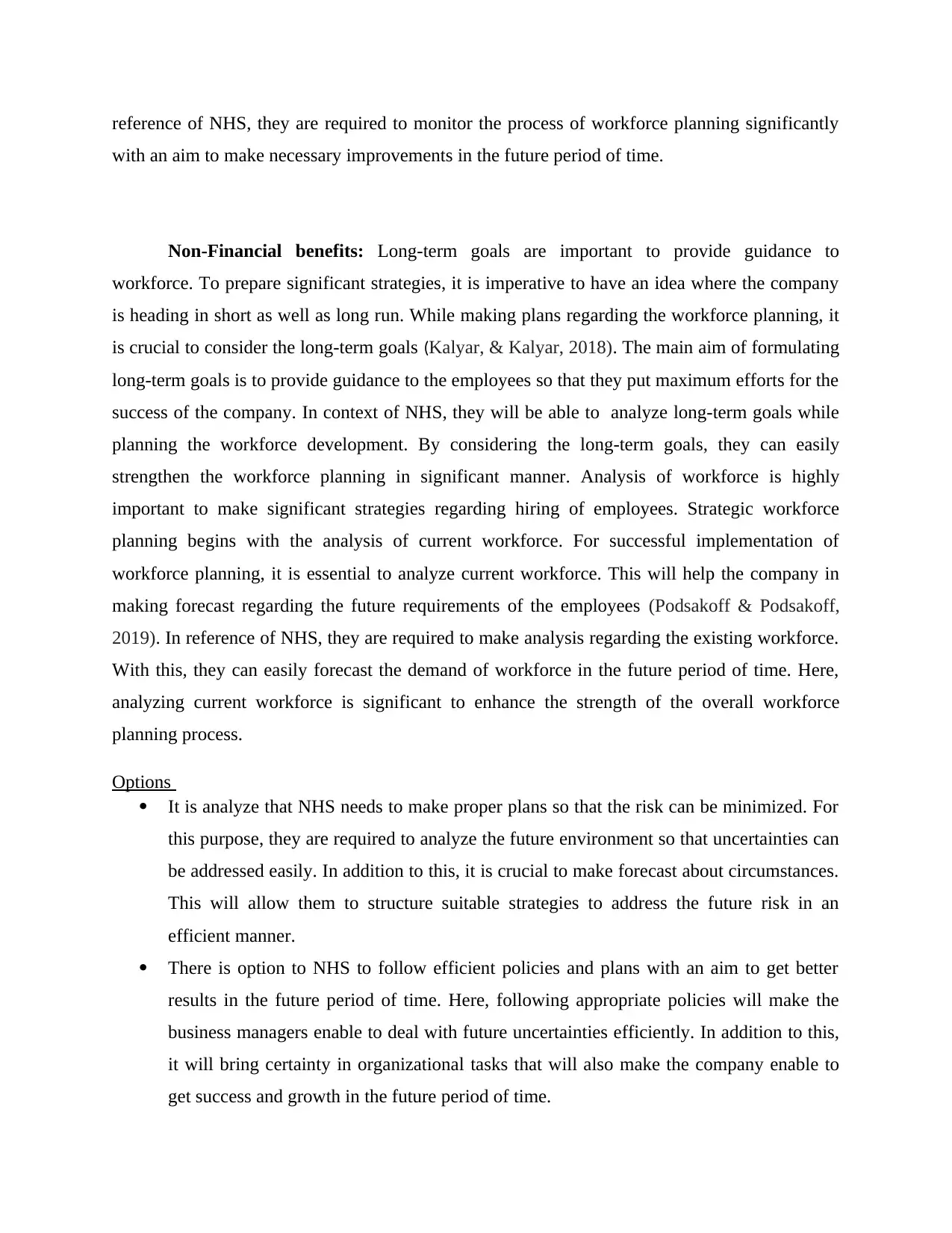
reference of NHS, they are required to monitor the process of workforce planning significantly
with an aim to make necessary improvements in the future period of time.
Non-Financial benefits: Long-term goals are important to provide guidance to
workforce. To prepare significant strategies, it is imperative to have an idea where the company
is heading in short as well as long run. While making plans regarding the workforce planning, it
is crucial to consider the long-term goals (Kalyar, & Kalyar, 2018). The main aim of formulating
long-term goals is to provide guidance to the employees so that they put maximum efforts for the
success of the company. In context of NHS, they will be able to analyze long-term goals while
planning the workforce development. By considering the long-term goals, they can easily
strengthen the workforce planning in significant manner. Analysis of workforce is highly
important to make significant strategies regarding hiring of employees. Strategic workforce
planning begins with the analysis of current workforce. For successful implementation of
workforce planning, it is essential to analyze current workforce. This will help the company in
making forecast regarding the future requirements of the employees (Podsakoff & Podsakoff,
2019). In reference of NHS, they are required to make analysis regarding the existing workforce.
With this, they can easily forecast the demand of workforce in the future period of time. Here,
analyzing current workforce is significant to enhance the strength of the overall workforce
planning process.
Options
It is analyze that NHS needs to make proper plans so that the risk can be minimized. For
this purpose, they are required to analyze the future environment so that uncertainties can
be addressed easily. In addition to this, it is crucial to make forecast about circumstances.
This will allow them to structure suitable strategies to address the future risk in an
efficient manner.
There is option to NHS to follow efficient policies and plans with an aim to get better
results in the future period of time. Here, following appropriate policies will make the
business managers enable to deal with future uncertainties efficiently. In addition to this,
it will bring certainty in organizational tasks that will also make the company enable to
get success and growth in the future period of time.
with an aim to make necessary improvements in the future period of time.
Non-Financial benefits: Long-term goals are important to provide guidance to
workforce. To prepare significant strategies, it is imperative to have an idea where the company
is heading in short as well as long run. While making plans regarding the workforce planning, it
is crucial to consider the long-term goals (Kalyar, & Kalyar, 2018). The main aim of formulating
long-term goals is to provide guidance to the employees so that they put maximum efforts for the
success of the company. In context of NHS, they will be able to analyze long-term goals while
planning the workforce development. By considering the long-term goals, they can easily
strengthen the workforce planning in significant manner. Analysis of workforce is highly
important to make significant strategies regarding hiring of employees. Strategic workforce
planning begins with the analysis of current workforce. For successful implementation of
workforce planning, it is essential to analyze current workforce. This will help the company in
making forecast regarding the future requirements of the employees (Podsakoff & Podsakoff,
2019). In reference of NHS, they are required to make analysis regarding the existing workforce.
With this, they can easily forecast the demand of workforce in the future period of time. Here,
analyzing current workforce is significant to enhance the strength of the overall workforce
planning process.
Options
It is analyze that NHS needs to make proper plans so that the risk can be minimized. For
this purpose, they are required to analyze the future environment so that uncertainties can
be addressed easily. In addition to this, it is crucial to make forecast about circumstances.
This will allow them to structure suitable strategies to address the future risk in an
efficient manner.
There is option to NHS to follow efficient policies and plans with an aim to get better
results in the future period of time. Here, following appropriate policies will make the
business managers enable to deal with future uncertainties efficiently. In addition to this,
it will bring certainty in organizational tasks that will also make the company enable to
get success and growth in the future period of time.
⊘ This is a preview!⊘
Do you want full access?
Subscribe today to unlock all pages.

Trusted by 1+ million students worldwide
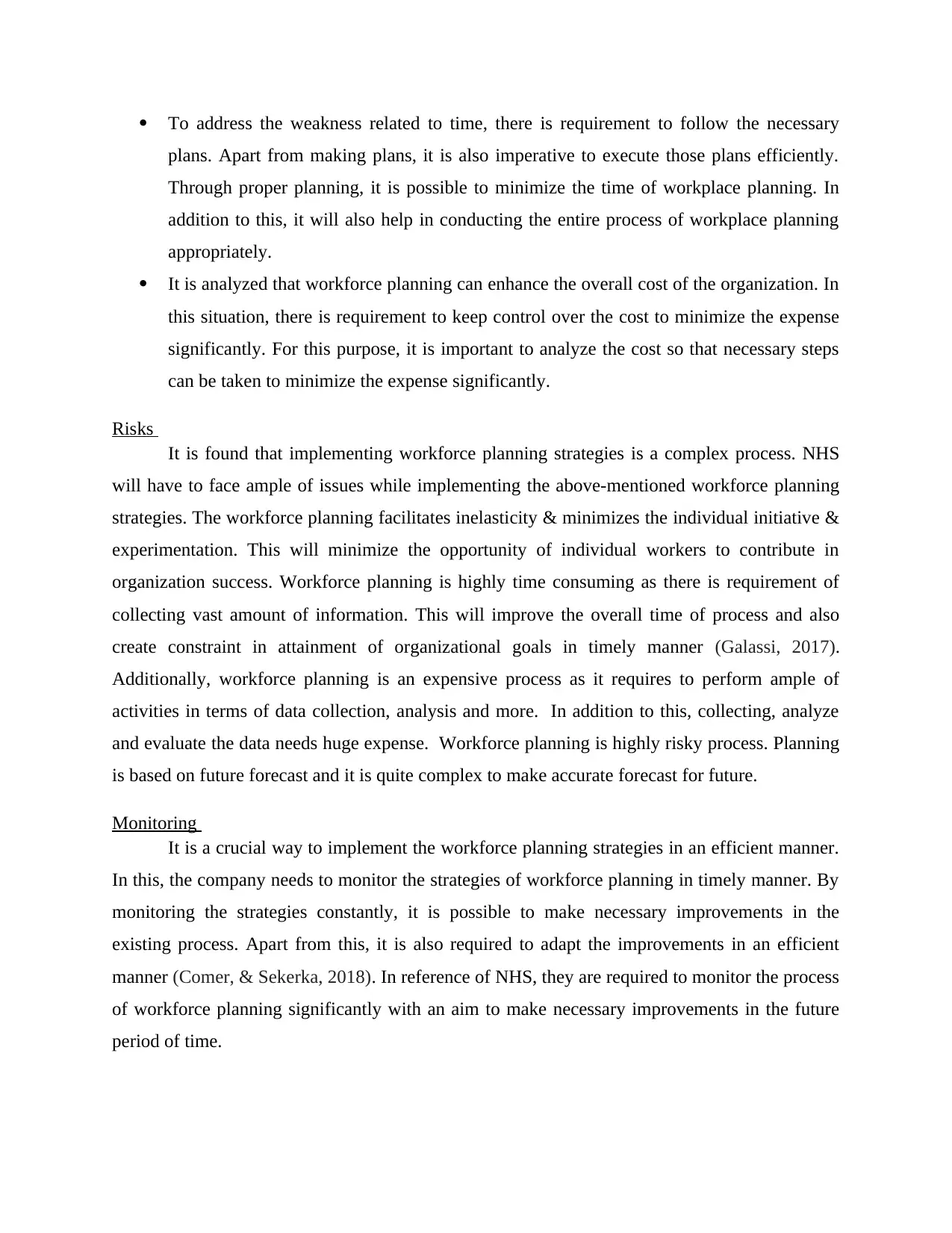
To address the weakness related to time, there is requirement to follow the necessary
plans. Apart from making plans, it is also imperative to execute those plans efficiently.
Through proper planning, it is possible to minimize the time of workplace planning. In
addition to this, it will also help in conducting the entire process of workplace planning
appropriately.
It is analyzed that workforce planning can enhance the overall cost of the organization. In
this situation, there is requirement to keep control over the cost to minimize the expense
significantly. For this purpose, it is important to analyze the cost so that necessary steps
can be taken to minimize the expense significantly.
Risks
It is found that implementing workforce planning strategies is a complex process. NHS
will have to face ample of issues while implementing the above-mentioned workforce planning
strategies. The workforce planning facilitates inelasticity & minimizes the individual initiative &
experimentation. This will minimize the opportunity of individual workers to contribute in
organization success. Workforce planning is highly time consuming as there is requirement of
collecting vast amount of information. This will improve the overall time of process and also
create constraint in attainment of organizational goals in timely manner (Galassi, 2017).
Additionally, workforce planning is an expensive process as it requires to perform ample of
activities in terms of data collection, analysis and more. In addition to this, collecting, analyze
and evaluate the data needs huge expense. Workforce planning is highly risky process. Planning
is based on future forecast and it is quite complex to make accurate forecast for future.
Monitoring
It is a crucial way to implement the workforce planning strategies in an efficient manner.
In this, the company needs to monitor the strategies of workforce planning in timely manner. By
monitoring the strategies constantly, it is possible to make necessary improvements in the
existing process. Apart from this, it is also required to adapt the improvements in an efficient
manner (Comer, & Sekerka, 2018). In reference of NHS, they are required to monitor the process
of workforce planning significantly with an aim to make necessary improvements in the future
period of time.
plans. Apart from making plans, it is also imperative to execute those plans efficiently.
Through proper planning, it is possible to minimize the time of workplace planning. In
addition to this, it will also help in conducting the entire process of workplace planning
appropriately.
It is analyzed that workforce planning can enhance the overall cost of the organization. In
this situation, there is requirement to keep control over the cost to minimize the expense
significantly. For this purpose, it is important to analyze the cost so that necessary steps
can be taken to minimize the expense significantly.
Risks
It is found that implementing workforce planning strategies is a complex process. NHS
will have to face ample of issues while implementing the above-mentioned workforce planning
strategies. The workforce planning facilitates inelasticity & minimizes the individual initiative &
experimentation. This will minimize the opportunity of individual workers to contribute in
organization success. Workforce planning is highly time consuming as there is requirement of
collecting vast amount of information. This will improve the overall time of process and also
create constraint in attainment of organizational goals in timely manner (Galassi, 2017).
Additionally, workforce planning is an expensive process as it requires to perform ample of
activities in terms of data collection, analysis and more. In addition to this, collecting, analyze
and evaluate the data needs huge expense. Workforce planning is highly risky process. Planning
is based on future forecast and it is quite complex to make accurate forecast for future.
Monitoring
It is a crucial way to implement the workforce planning strategies in an efficient manner.
In this, the company needs to monitor the strategies of workforce planning in timely manner. By
monitoring the strategies constantly, it is possible to make necessary improvements in the
existing process. Apart from this, it is also required to adapt the improvements in an efficient
manner (Comer, & Sekerka, 2018). In reference of NHS, they are required to monitor the process
of workforce planning significantly with an aim to make necessary improvements in the future
period of time.
Paraphrase This Document
Need a fresh take? Get an instant paraphrase of this document with our AI Paraphraser
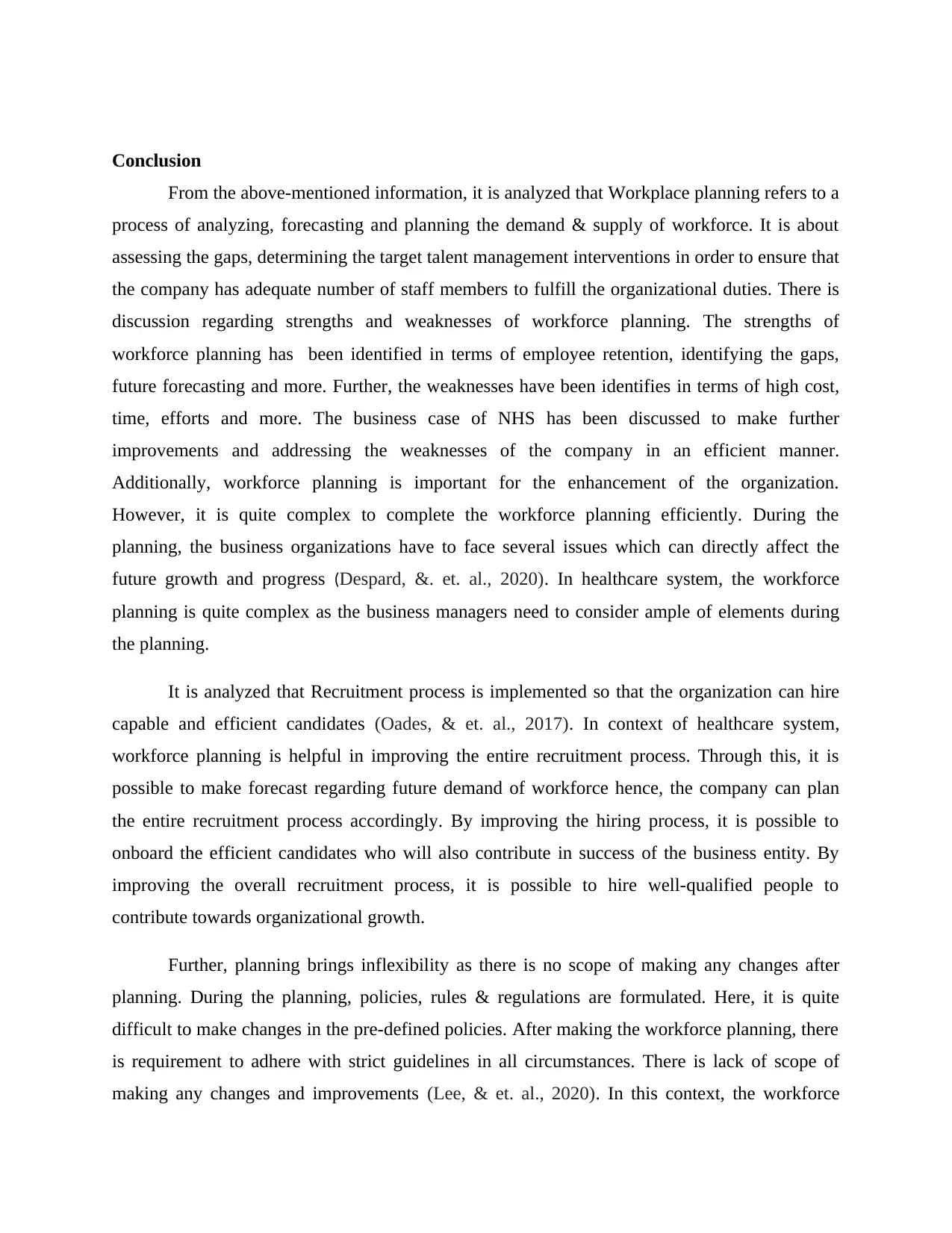
Conclusion
From the above-mentioned information, it is analyzed that Workplace planning refers to a
process of analyzing, forecasting and planning the demand & supply of workforce. It is about
assessing the gaps, determining the target talent management interventions in order to ensure that
the company has adequate number of staff members to fulfill the organizational duties. There is
discussion regarding strengths and weaknesses of workforce planning. The strengths of
workforce planning has been identified in terms of employee retention, identifying the gaps,
future forecasting and more. Further, the weaknesses have been identifies in terms of high cost,
time, efforts and more. The business case of NHS has been discussed to make further
improvements and addressing the weaknesses of the company in an efficient manner.
Additionally, workforce planning is important for the enhancement of the organization.
However, it is quite complex to complete the workforce planning efficiently. During the
planning, the business organizations have to face several issues which can directly affect the
future growth and progress (Despard, &. et. al., 2020). In healthcare system, the workforce
planning is quite complex as the business managers need to consider ample of elements during
the planning.
It is analyzed that Recruitment process is implemented so that the organization can hire
capable and efficient candidates (Oades, & et. al., 2017). In context of healthcare system,
workforce planning is helpful in improving the entire recruitment process. Through this, it is
possible to make forecast regarding future demand of workforce hence, the company can plan
the entire recruitment process accordingly. By improving the hiring process, it is possible to
onboard the efficient candidates who will also contribute in success of the business entity. By
improving the overall recruitment process, it is possible to hire well-qualified people to
contribute towards organizational growth.
Further, planning brings inflexibility as there is no scope of making any changes after
planning. During the planning, policies, rules & regulations are formulated. Here, it is quite
difficult to make changes in the pre-defined policies. After making the workforce planning, there
is requirement to adhere with strict guidelines in all circumstances. There is lack of scope of
making any changes and improvements (Lee, & et. al., 2020). In this context, the workforce
From the above-mentioned information, it is analyzed that Workplace planning refers to a
process of analyzing, forecasting and planning the demand & supply of workforce. It is about
assessing the gaps, determining the target talent management interventions in order to ensure that
the company has adequate number of staff members to fulfill the organizational duties. There is
discussion regarding strengths and weaknesses of workforce planning. The strengths of
workforce planning has been identified in terms of employee retention, identifying the gaps,
future forecasting and more. Further, the weaknesses have been identifies in terms of high cost,
time, efforts and more. The business case of NHS has been discussed to make further
improvements and addressing the weaknesses of the company in an efficient manner.
Additionally, workforce planning is important for the enhancement of the organization.
However, it is quite complex to complete the workforce planning efficiently. During the
planning, the business organizations have to face several issues which can directly affect the
future growth and progress (Despard, &. et. al., 2020). In healthcare system, the workforce
planning is quite complex as the business managers need to consider ample of elements during
the planning.
It is analyzed that Recruitment process is implemented so that the organization can hire
capable and efficient candidates (Oades, & et. al., 2017). In context of healthcare system,
workforce planning is helpful in improving the entire recruitment process. Through this, it is
possible to make forecast regarding future demand of workforce hence, the company can plan
the entire recruitment process accordingly. By improving the hiring process, it is possible to
onboard the efficient candidates who will also contribute in success of the business entity. By
improving the overall recruitment process, it is possible to hire well-qualified people to
contribute towards organizational growth.
Further, planning brings inflexibility as there is no scope of making any changes after
planning. During the planning, policies, rules & regulations are formulated. Here, it is quite
difficult to make changes in the pre-defined policies. After making the workforce planning, there
is requirement to adhere with strict guidelines in all circumstances. There is lack of scope of
making any changes and improvements (Lee, & et. al., 2020). In this context, the workforce
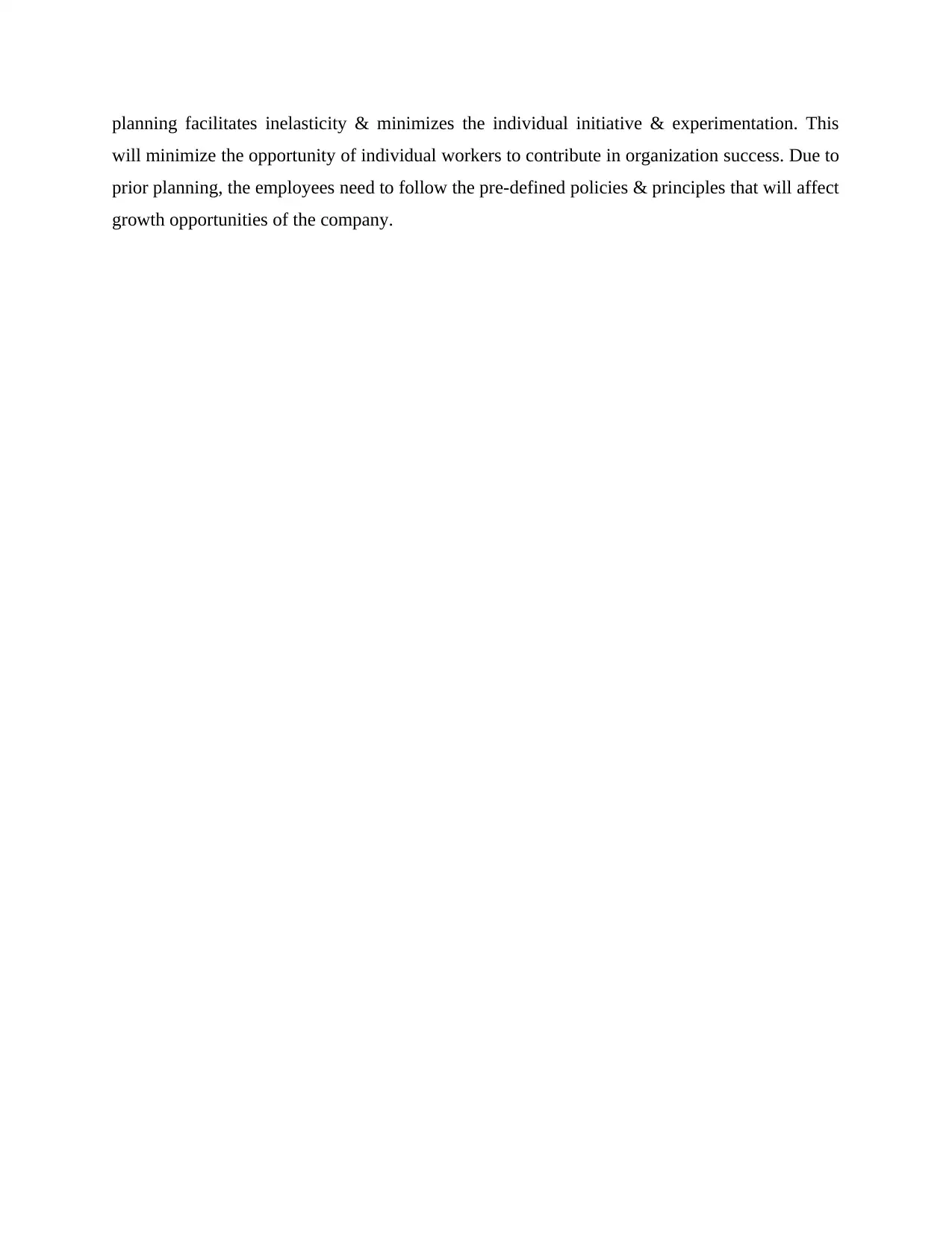
planning facilitates inelasticity & minimizes the individual initiative & experimentation. This
will minimize the opportunity of individual workers to contribute in organization success. Due to
prior planning, the employees need to follow the pre-defined policies & principles that will affect
growth opportunities of the company.
will minimize the opportunity of individual workers to contribute in organization success. Due to
prior planning, the employees need to follow the pre-defined policies & principles that will affect
growth opportunities of the company.
⊘ This is a preview!⊘
Do you want full access?
Subscribe today to unlock all pages.

Trusted by 1+ million students worldwide
1 out of 14
Related Documents
Your All-in-One AI-Powered Toolkit for Academic Success.
+13062052269
info@desklib.com
Available 24*7 on WhatsApp / Email
![[object Object]](/_next/static/media/star-bottom.7253800d.svg)
Unlock your academic potential
Copyright © 2020–2025 A2Z Services. All Rights Reserved. Developed and managed by ZUCOL.




